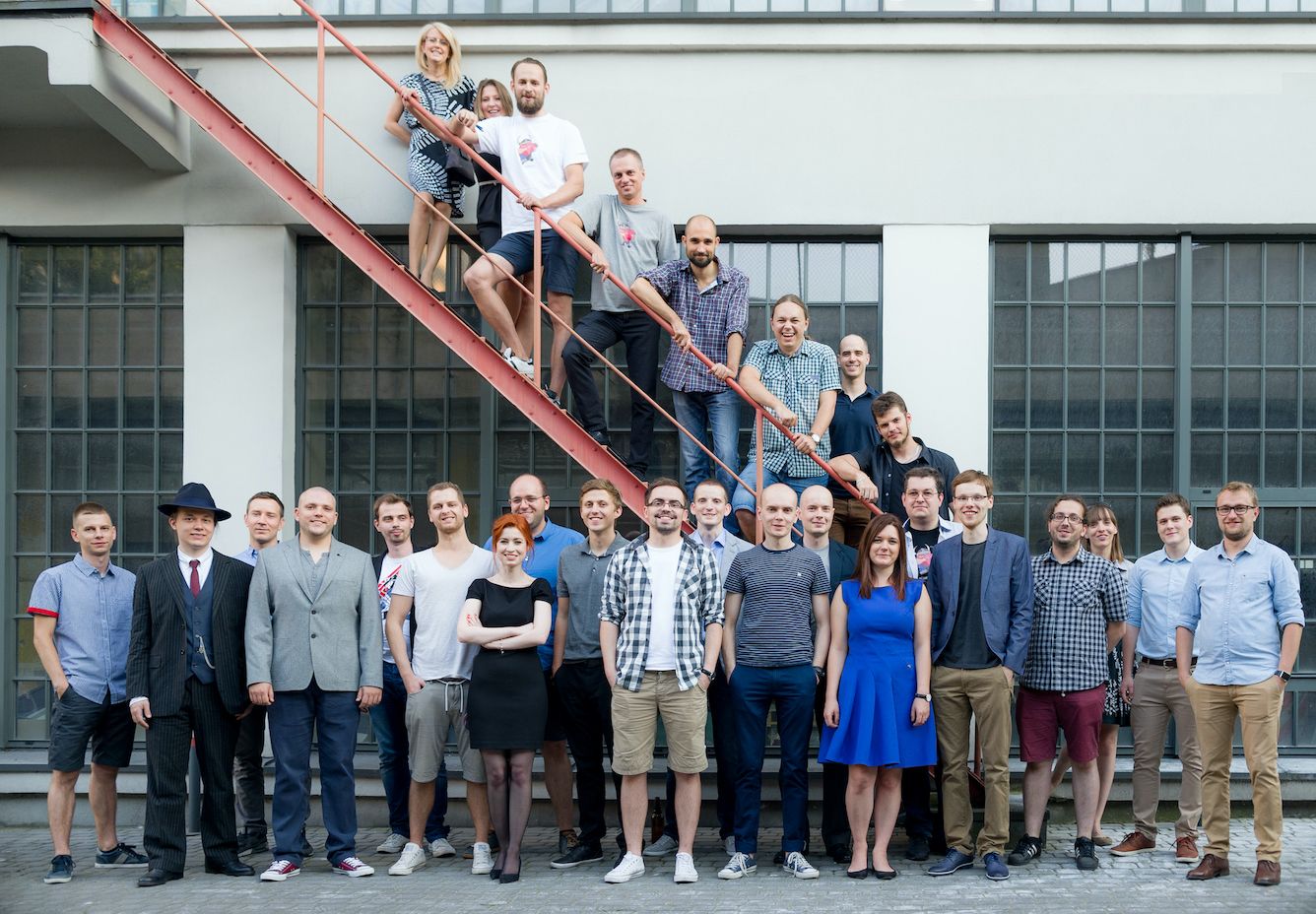How I transformed from a regular developer into a CEO of 30 people company overnight

During my studies, I became a DevOps engineer at Ragnarson, a software consultancy based in Łódź, Poland. The company was run by Łukasz Piestrzeniewicz, one of the key people in the Polish Ruby on Rails scene.
The work environment Łukasz and other colleagues have created was awesome. We felt like we owned a part of the company, and actually me and a few other people became its minor shareholders within the next few years.
But in late 2013, things weren’t looking good. We lost a major customer. Shellycloud.com, our own hosting startup (a Heroku alternative) was burning more money than we predicted. Łukasz was very stressed and we felt that he lost control over the company.
We’ve seen his struggle and together with the team decided to have a serious talk with him. We wanted to help, but didn’t know how. All we’ve been doing so far was just coding. The talk was tough but it resulted in Łukasz sharing some of his responsibilities with us. And then, 6 months later, he died.
It was brain cancer. Three weeks after his diagnosis, he went through a surgery that failed. We were all deep in grief and shock.
And we didn’t know what to do. We just couldn’t throw away everything Łukasz built, and we really felt like the company is a part of our family. But, on the other hand, we didn’t know anything about managing a company. Where did the customers come from? How to manage the cash flow? How to run the company? And so on.
Normally, entrepreneurs build their companies from the ground up, learning everything as they go. We were left with the decision to take over and run quite a big operation without any of that. Also, when we analysed the situation, it didn’t look so bright. The biggest project (30% of our revenue) was about to finish soon. The company had $30k cash in the bank and we were able to maintain a positive cashflow only thanks to a revolving loan.
We were scared, but we decided to stand up to the challenge. Together with me, four minor shareholders took over the management of the company. I became a CEO at 25 years old.
This is when the most challenging and rewarding five years of my life started.

Crazy times
The first episode of this story was the crazy 6 months we spent on trying to understand the company and take over responsibilities from simple tasks like paying taxes to negotiations with the customers. We didn’t know what to do but we started to do it, and with each month things became more understandable. We divided the responsibilities, met with customers, analysed our finances, and so on.
In the end we realised that, as for now the most important thing and at the same the toughest one, was bringing in new customers to fill a massive revenue gap after a loss of a big customer.
During all those years when Łukasz ran the company, our customers mainly came from Germany. The best idea we came up with was having me move to Berlin and start a “sales office” there. I still didn’t know how to get across to those people, but being there made it all more real.
Berlin
On November 1st, 2014, I arrived in Berlin, rented an Airbnb and started thinking about what to do next. I needed to meet some people and build my business network - and do it fast (no pressure at all).
I started meeting with people from Łukasz’s network, our customers, past customers, everyone I could contact. We didn’t have a proper CRM in place, so a lot of those contacts disappeared with Łukasz. The meetings were nice and compassionate (imagine meeting a 25-year-old scared kid who moved to a big city with a business card labeled “CEO”) but didn’t bring any business.
So I started to attend every kind of business networking event I could find in Berlin. Most of the time, I met guys like me coming from Eastern Europe and trying to pitch their services to German startups. I became better and better at networking, but it still didn’t work well. There was a lot of competition and I lacked confidence in what I was trying to sell.
On the other hand, I tried to organize my personal life in Berlin. My girlfriend moved with me and we tried to find our place in the city.
Up and to the right
Then, a small miracle happened. Out of the blue, one of our past customers introduced us to a startup that needed exactly the skills we had. They needed to hire a large team fast; fortunately, we had people ready to work right away. The project was big enough to totally turn the table. We began 1.5 years of prosperity. Soon, the next big project happened, we became fully booked, and started to hire new people. We were able to find a project for each new developer almost instantly.
We started to make internal changes, parted with two founders and brought one more (Grzegorz Kołodziejczyk) onboard. We were in love with ideas like teal organizations and holocracy so we started to slowly change into a flat, totally transparent company.
From sad-poles-looking-for-hire we changed into kings of life as money poured into the company like never before. We were so confident that we were nailing it that during the next months we hired 8 people we didn’t have a project for, waiting for the next customer to call us.
We weren’t the wolves of Wall Street yet, but we came pretty close. It lasted for over a year.
On August 12th, 2016, Friday at 17.44 (I remember the moment as if it was yesterday) our biggest customer called us saying that he was ending the contract immediately and within 2 weeks several developers were going to be left without a project.
We still believed that we would figure it out with our good run. But 6 weeks later, the second biggest customer told us that his funding is finished and we need to stop our collaboration.
The crisis and the second miracle
Things started to look really bad. We were burning more cash than ever and needed to act fast. We decided to lay off 30% of the people and cut all of the costs we could. And then get back to figuring out how to get new customers on board.
2017 was the year when we tried all the ideas we could come up with. From content marketing to networking, ad campaigns and cold mailing. We traveled all over Europe trying to find a new project.
Eventually, we were able to bring in a few smaller projects, but they didn’t change our situation.
The help came from a totally different direction. Back in the beginning of 2016, Guy, a friend of Ragnarson, called me saying that he had spotted an awesome startup that needed our help. But they didn’t have any cash at the time.
A few months later, he called me again, this time to tell me that this startup still didn’t have cash for our services, but he decided to join them. I knew that if Guy decided to engage, there was a big chance that they would succeed.
After an internal discussion, we decided to take the risk and lend a few developers for this project free of charge, counting on the idea to sprout.
This startup was Vehiculum, today one of the leaders in the car rental space with over 100 employees and 10 mln EUR in funding. In 2017, they were able to start paying for our services and their needs grew. We began to secure our situation.
At the same time, referrals from our customers started to come in and we kicked off new projects. At the end of 2017, we were back on track. But this time, we did it without the “wolves of Wall Street” attitude. We rebuilt the company slowly up to the point where we are right now.

And where are we exactly?
Our customers include some of the top European startups, such as Vehiculum, HeyJobs, GrowthMentor, and mature organisations like A-connect, Verivox, and the Zurich University of Art.
Our team is smaller than during the times of prosperity, but we constantly hire new developers.
We have a stable situation and were able to secure enough cash that we decided to invest in impactful pre-seed startups. In 2019 we started the Ragnarson Fund which is a big part of our strategy for the years to come.
We feel that we understand and control our business. We changed into a teal organisation, hired a marketing team, and know exactly where we are and where we want to be. We are still keeping Łukasz’s legacy alive, but made it our own way.
What did I learn?
I had no idea what I was getting into back in 2014 when I decided to take over as a CEO. It happened to be a rocky road, with a lot of ups and downs. It was the most challenging time of my life but also the time when I learned the most about running a business and myself.
Here are three important takeaways I got from my story.
Humility
Failures and crises bring a lot of learning opportunities. When you go through all the phases of the business cycle, you start to understand how easy it is to lose everything. It reminds you of the times of prosperity and how you wasted it on doing the wrong things while you still had the chance to have some control over your future. I was quite aware of the danger of going bankrupt but I still had a hard time doing something about it. I’m much more humble today after all those lessons.
There are a lot of things that you can do, but only a few that really matter
At the beginning of this journey, I had a vague and limited understanding of the complexity of running a business. Once you focus on improving something, you quickly learn that things are more complicated than you thought. You can spend 12h each day running a business, but still feel that there is much more you should do. That's why you have to focus on the essentials. In our case, it was sales and it took some time before we realized that despite how hard it is for us, it’s the only thing we need to focus on.
Sharing the responsibility
It takes time to learn how deep you should go, and where the right balance between quality and a good-enough solution is. In the meantime, life happens and messes with you, your team, and your plans. To be able to navigate the situation I needed to appreciate how complex, unpredictable and messy the world of building companies is, and how many skills and how much collaboration is required to make it work in the long run. That’s why having a team of employees and co-founders that have your back is what helped me the most. Being a teal organisation means that the responsibility for the success and failures is shared among the team, and though difficult to build, it helped us to survive the toughest moments.
